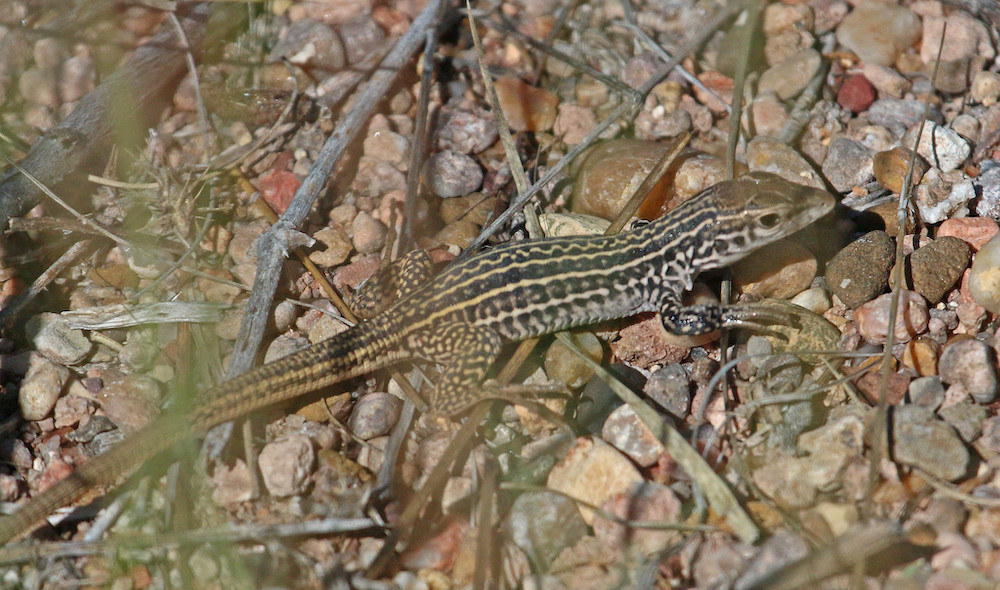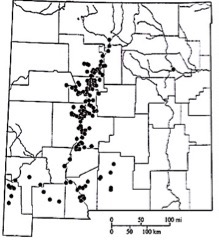
By Anthony Sena, Emeritus Professor, Northern New Mexico College
I have noticed quite a few fence lizards, Sceloporus undulatus, in and around a small arroyo that runs through my yard and on the walls of our home. This is the most common lizard seen around homes and gardens in Northern New Mexico. Female fence lizards lay two clutches of eggs during the spring and summer seasons, so they and the males must spend significant time outside of their burrows during the day. Like most lizards they are wary and quick, but if a person is non-threatening or temporarily motionless they eventually relax and scurry about looking for food, mating partners, and, if they happen to be males, potential competitors.
When males encounter other males they perform an instinctive behavioral ritual of front limb push-ups and rapid head bobbing, which is interesting and amusing. It is also fun to watch them thermoregulate as they move from basking in open sunlight to plant covered shaded areas or to see them touch their snouts to water drops on freshly watered plants.
They do not actively drink, preferring to let moisture creep along their scales into their mouth. It seems like we have been having a higher percentage of high winds this spring, which, in general, reduces sightings of lizards. Lizards are bothered by wind and one reason for this may be that it generally makes finding insects much more difficult. (I also dislike spring winds because of juniper pollen!)
The New Mexico whiptail lizard, Aspidoscelis neomexicanus, is the New Mexico state reptile. Its distribution in the state closely follows the Rio Grande from Española south into Texas, with a few sparse and localized populations far removed from the river in several southwest counties of New Mexico. In Northern New Mexico, the lizard prefers areas of low shrubs and grasslands in perpetually disturbed sandy habitat along the river.
The New Mexico whiptail is an all-female parthenogenetic species that was produced by an original mating of two related but distinct whiptail species. Because of this, New Mexico whiptails have one-half of all their chromosomes derived from one type of parent lizard and one-half from another species. In most cases, hybridizations of this type between vertebrate species result in sterility of the offspring, but sometimes surprising outcomes like parthenogenesis, or “virgin-birth,” occur, where all subsequent generations of offspring produced by the hybrid are genetically identical to the mother.

In a couple of remarkable studies published in 1975, Dr. Orlando Cuellar from the University of Utah provided evidence that populations of New Mexico whiptails were over 99% identical from Rio Arriba to Socorro County. More recent and current studies continue to show very little genetic variability within populations of this species. Some parthenogenetic species have shown a fascinating pseudo-mating ritual where females alternate male-like behaviors at given times in the “mating” season. This behavior is providing interesting details on brain hormones and reproductive development, even in all-female parthenospecies like the New Mexico whiptail.
A similar species, the little striped whiptail, Aspidoscelis inornatus, that may be confused with the New Mexico whiptail, is more commonly seen in the Española Valley in areas further removed from the Rio Grande, but the little striped whiptail lacks the distinctive wavy line found on the mid-back of the New Mexican whiptail lizard. An interesting note is that the little striped whiptail is the known (by matching chromosomal size and banding characteristics) parental species of the New Mexico whiptail!
In my immediate vicinity, there are few areas that provide easy access to the riverbank (most are private or Pueblo land), and unfortunately I have not observed any New Mexico whiptails this spring.
If you observe a New Mexico whiptail or another lizard, we’d love to hear about it! Send your photo or story to takeitoutside@peecnature.org.
